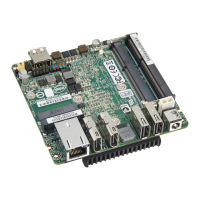
Do you have a question about the Intel D33217GKE and is the answer not in the manual?
| Product Collection | Intel® Desktop Board |
|---|---|
| Intel® vPro™ Technology | No |
| Intel® High Definition Audio Technology | Yes |
| Intel® Rapid Start Technology | Yes |
| Intel® Anti-Theft Technology | Yes |
| Intel® Visual BIOS | Yes |
| Consumer Infrared Rx Sensor | No |
| Number of USB Ports | 8 |
| USB Revision | 2.0, 3.0 |
| Integrated Wireless | No |
| Integrated Bluetooth | No |
| S/PDIF Out Connector | Yes |
| HDMI Port | 1 |
| eSATA Port | No |
| Number of Memory Channels | 2 |
| Max Memory Bandwidth | 25.6 GB/s |
| Number of DIMMs | 2 |
| ECC Memory Supported | No |
| Memory Slots | 2 |
| USB Ports | 8 |
| Video Outputs | HDMI |
| Supported Operating Systems | Windows 8, Windows 7 |
| Internal Drive Form Factor | 2.5" |
| Integrated LAN | Yes |
| Memory Types | DDR3 |
| LAN | 10/100/1000 Mbps |
| Storage Interfaces | SATA 6.0 Gb/s |
| Power Connector | 24-pin ATX |
Defines the target audience for this technical specification.
Lists the chapters and sections covered in the document.
Explains symbols and abbreviations used throughout the specification.
Provides a summary of the board's major features.
Describes the onboard Intel Core i3-3217U processor.
Details the SO-DIMM sockets and supported memory configurations.
Explains the chip-to-chip connection between processor and PCH.
Details how display data is processed and sent to monitors.
Covers the integrated graphics features.
Explains the support for AHCI storage mode.
Details the Gigabit Ethernet controller and its features.
Details the hardware monitoring features based on an embedded controller.
Explains how fan monitoring can be implemented.
Explains ACPI's role in system power management.
Lists devices/events that can wake the computer from sleep states.
Discusses addressable system memory and its allocation.
Details the 16 GB addressable memory and space allocation.
Lists system memory addresses and their descriptions.
Shows and lists the back panel connectors.
Illustrates internal connectors and headers on the bottom side.
Details the board's form factor and dimensions.
Covers external and internal power supply options.
Lists the current capability of the fan headers.
Provides MTBF prediction for the board.
Lists the environmental specifications for the board.
Introduces the Intel Visual BIOS and its storage.
Explains SMBIOS for managing computers in a network.
Describes how legacy USB support enables older devices.
Explains how to augment the default splash screen.
Details media types for BIOS recovery.
Allows booting from the onboard LAN or network card.
Explains how to change boot device via POST menu.
Describes blink patterns for front panel LEDs indicating errors.
Lists common BIOS error messages and their explanations.
Explains POST codes output to I/O port 80h for diagnostics.
Details regulatory compliance information and standards.
Lists safety standards the board complies with.
Provides the EU Declaration of Conformity.
Addresses materials regulated upon disposal.
Details Intel's product recycling program.
States compliance with Canadian radio noise emission limits.
Translation of Korea Class B statement for home use.
